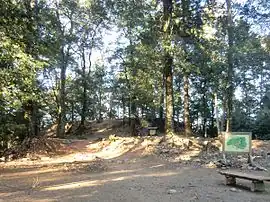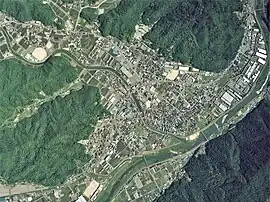Akitakata
Akitakata (安芸高田市, Akitakata-shi) is a city located in north-central Hiroshima Prefecture, Japan. As of 1 May 2023, the city had an estimated population of 26,810 in 13,319 households and a population density of 50 persons per km².[1] The total area of the city is 537.75 square kilometres (207.63 sq mi).The city lays claim to be the birthplace and hometown of Mōri Motonari, the Sengoku period daimyō of the 16th century.
Akitakata
安芸高田市 | |
|---|---|
 Akitakata city hall | |
 Flag  Emblem | |
Location of Akitakata in Hiroshima Prefecture | |
 | |
 Akitakata Location in Japan | |
| Coordinates: 34°39′47″N 132°42′23″E | |
| Country | Japan |
| Region | Chūgoku (San'yō) |
| Prefecture | Hiroshima |
| Government | |
| • Mayor | Shinji Ijimaru (since August 2020) |
| Area | |
| • Total | 537.75 km2 (207.63 sq mi) |
| Population (May 1, 2023) | |
| • Total | 26,810 |
| • Density | 50/km2 (130/sq mi) |
| Time zone | UTC+09:00 (JST) |
| City hall address | Yoshidachō, Yoshida 791, Akitakata-shi, Hiroshima-ken 731-0592 |
| Website | Official website |
| Symbols | |
| Flower | Hydrangea |
| Tree | Cherry blossom |


Geography
Akitakata is located in north-central Hiroshima Prefecture, and is surrounded by the Chugoku Mountains. The Midori and Takamiya neighborhoods of the city are designated as heavy snowfall areas.
Adjoining municipalities
Climate
Akitakata has a Humid subtropical climate (Köppen Cfa) characterized by warm summers and cool winters with light to no snowfall. The average annual temperature in Akitakata is 13.0 °C. The average annual rainfall is 1581 mm with September as the wettest month. The temperatures are highest on average in August, at around 24.8 °C, and lowest in January, at around 1.6 °C.[2]
Demographics
Per Japanese census data,[3] the population of Izumi has risen steadily over the past century.
| Year | Pop. | ±% |
|---|---|---|
| 1950 | 57,214 | — |
| 1960 | 49,715 | −13.1% |
| 1970 | 38,541 | −22.5% |
| 1980 | 36,984 | −4.0% |
| 1990 | 36,115 | −2.3% |
| 2000 | 34,439 | −4.6% |
| 2010 | 31,497 | −8.5% |
| Higashihiroshima population statistics[4] | ||
History
The area of Akitakata is part of ancient Aki Province. During the Sengoku period, the Mōri clan, once minor local warlords, rose under the leadership of Mōri Motonari to dominate the Chūgoku region of western Japan. The 1540-1541 Siege of Koriyama between the Mōri clan and the rival Amago clan occurred in what is now the Yoshida neighborhood of Akitakata.[5] After the establishment of the Tokugawa Shogunate, the area was part of the holdings of Hiroshima Domain. Following the Meiji restoration, the area was organized into villages within Takata District, including the village of Yoshida, with the creation of the modern municipalities system on April 1, 1889. Yoshida was raised to town status on January 1, 1896. The city of Akitakata was established on March 1, 2004, from the merger Yoshida with the towns of Kōda, Midori, Mukaihara, Takamiya, Yachiyo (all from Takata District). Therefore, Takata District was dissolved as a result of this merger.
Government
Akitakata has a mayor-council form of government with a directly elected mayor and a unicameral city council of 16 members. Akitakata contributes one member to the Hiroshima Prefectural Assembly. In terms of national politics, the city is part of the Hiroshima 3rd district of the lower house of the Diet of Japan.
Hiroshima vote-buying scandal
The mayor of Akitakata, Hiroshi Kodama, admitted receiving 600,000 yen from former Minister of Justice Katsuyuki Kawai and appeared at a news conference on 26 June 2020 with a shaved head to express his remorse. He resigned a week later, having stayed in office for only two and a half months. Other recipients of the cash gifts included several elected representatives in the city, amongst them the Speaker and the vice-Speaker of the Municipal Assembly.[6]
Economy
The economy of Akitaka is based on agriculture and food processing.
Education
Akitakata has nine public elementary schools and six public junior high schools operated by the city government, and two public high schools operated by the Hiroshima prefectural Board of Education.
Transportation
Sister city relations
 - Selwyn District, New Zealand, since September 9, 1992.
- Selwyn District, New Zealand, since September 9, 1992.
Local attractions
Akitakata is a mountainous farming area known for many traditional events as well as certain food products. One such food product is Ebisu tea, a sweet fragrant tea, that comes from Mukaihara Town. Another is yuzu juice (柚子ジュース), a product of the Kawane area of Takamiya town in the northeastern part of the city.
Notable places
- Yoshida-Kōriyama Castle ruins, Main stronghold of the Mōri clan, National Historic Site
- Tajihi-Sarugake Castle ruins. Mōri Motonari spent 23 years at this location. National Historic Site
- Akitakata City Historical Museum
- TS-Takata Circuit
Culture
Kagura, an ancient traditional form of Shinto dance and music, is still alive there today. The towns of Midori and Takamiya practice the "new dance" style, which is not actually new at all, just a later emergent performance style compared to the "old style". (There is a Kagura village in Midori town called Kaguramonzentojimura where various Kagura performances and competitions begin in August and last until December.)
Akitakata City is in the countryside, and still maintains many traditional local festivals. One such is Hanadaue, or rice-planting festival where men play flutes and taiko while women sing and plant rice.
References
- "Akitakata city official statistics" (in Japanese). Japan.
- Akitakata climate data
- Izumi population statistics
- Higashihiroshima population statistics
- Akitakata City Promotion Department, Commerce, Industry, and Tourism Division Historical Guide 2004
- "More Japan politicians admit accepting cash from ex-justice minister, but few resign". The Mainichi. 2020-07-02. Retrieved 2021-01-14.
External links
 Media related to Akitakata, Hiroshima at Wikimedia Commons
Media related to Akitakata, Hiroshima at Wikimedia Commons- Akitakata City official website (in Japanese)
- Kagura Village in Midori (in Japanese)